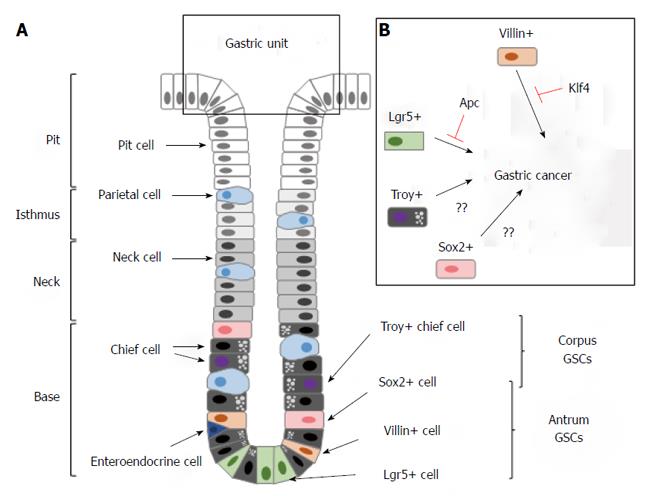Copyright
©The Author(s) 2015.
World J Gastroenterol. Jan 7, 2015; 21(1): 112-123
Published online Jan 7, 2015. doi: 10.3748/wjg.v21.i1.112
Published online Jan 7, 2015. doi: 10.3748/wjg.v21.i1.112
Figure 2 Stem cells that reside in gastric units.
A: An illustration of a gastric unit and the presence of several populations of gastric stem cells (GSCs), all of which can replenish the entire cellular population of the gastric units. In the antrum, Villin+ and Lgr5+ GSCs represent the quiescent and actively dividing stem cells, respectively. Villin+ GSCs are located in the lower third, while Lgr5+ GSCs are often found at the base of the gastric unit. In the corpus, populations of Troy+ chief cells that reside in the base are multipotent GSCs. Sox2+ GSCs are present in both the antrum and the corpus; B: The transformation of GSCs that reside in the stomach can lead to gastric cancer. The inactivation of Klf4 in Villin+ GSCs or of Apc in Lgr5+ GSCs can lead to gastric cancer in the antrum in mouse models. It is remains unclear whether the transformation of Troy+ or Sox2+ GSCs can cause gastric cancer in the corpus. GSCs: Gastric stem pcells.
- Citation: Zhao Y, Feng F, Zhou YN. Stem cells in gastric cancer. World J Gastroenterol 2015; 21(1): 112-123
- URL: https://www.wjgnet.com/1007-9327/full/v21/i1/112.htm
- DOI: https://dx.doi.org/10.3748/wjg.v21.i1.112









